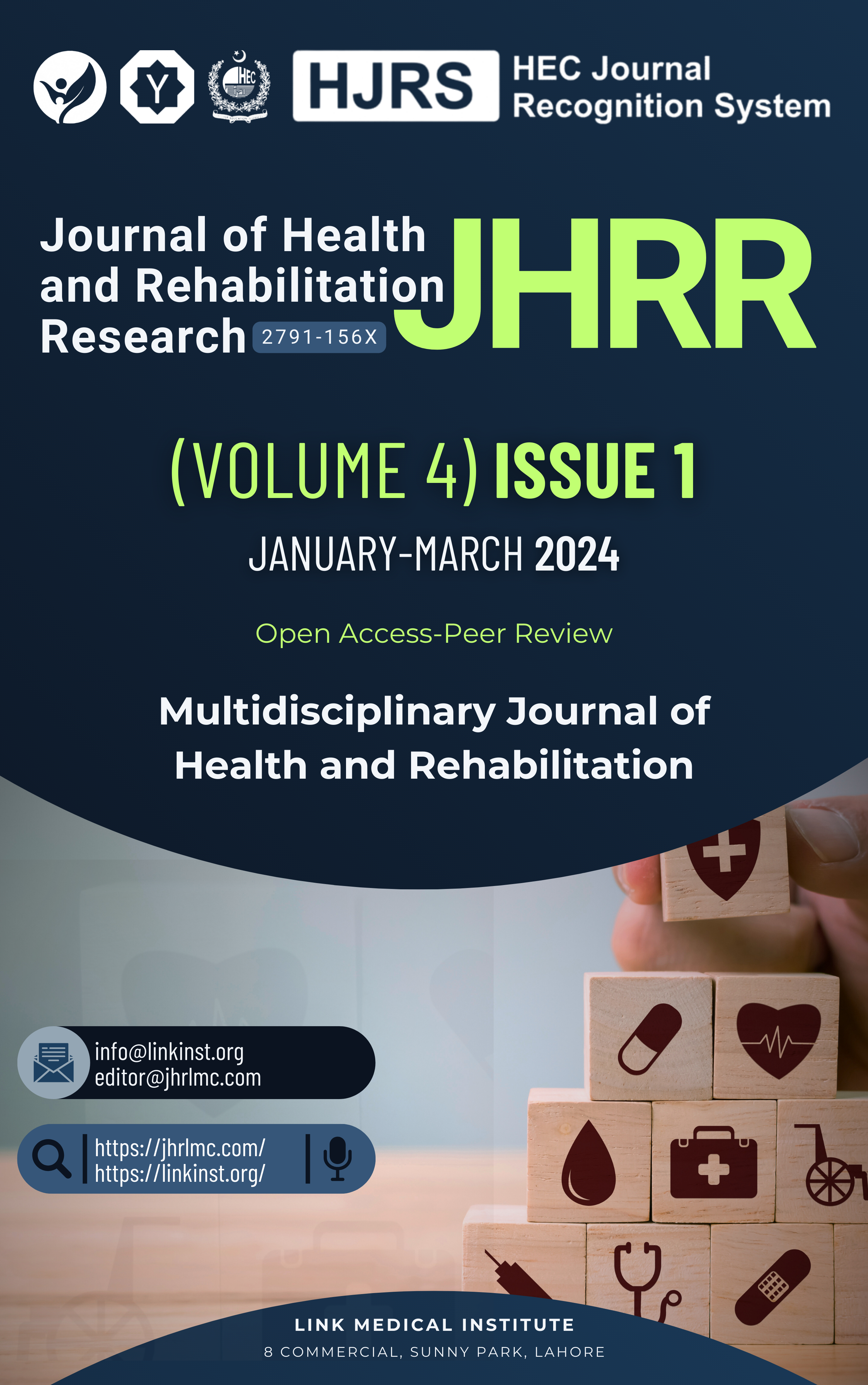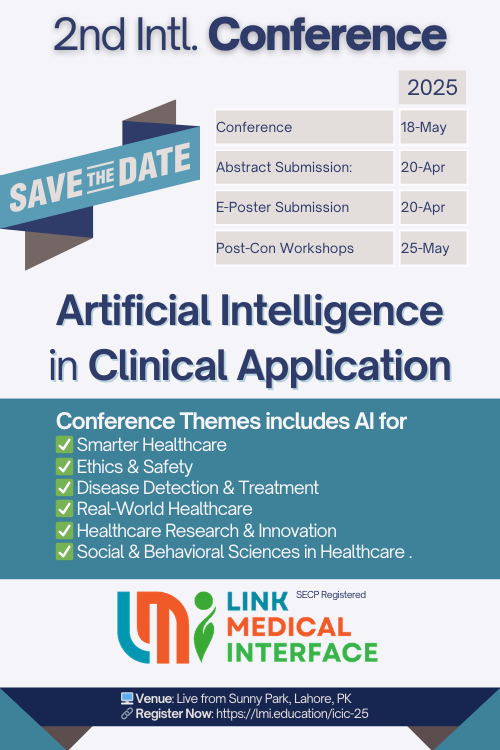Assessment of Infection Control Practices among Healthcare Workers Working at Tertiary Care Hospital of Larkana, Sindh: A Cross Sectional Survey
DOI:
https://doi.org/10.61919/jhrr.v4i1.642Keywords:
Healthcare-associated infections, Infection prevention and control, Hand hygiene, Tertiary care hospital, Healthcare workers, Cross-sectional surveyAbstract
Background: The increasing prevalence of healthcare-associated infections (HCAIs) represents a significant challenge to patient safety worldwide, particularly in tertiary care settings where the risk of transmission is heightened. Effective infection prevention and control (IPC) practices, including hand hygiene, are pivotal in mitigating these risks. Despite the critical importance of these measures, adherence varies significantly across different healthcare settings, especially in low and middle-income countries.
Objective: This study aims to assess the knowledge, attitudes, and self-reported practices related to infection control among healthcare workers in a tertiary care hospital in Larkana, with a specific focus on hand hygiene practices. The study seeks to identify gaps in knowledge and practice that could be targeted to improve overall IPC measures within the hospital.
Methods: A cross-sectional survey was conducted among healthcare workers at a tertiary care hospital in Larkana, utilizing a WHO-validated self-administered questionnaire. The survey covered various aspects of IPC, including hand hygiene knowledge, attitudes towards infection control, and self-reported adherence to IPC practices. The participants included doctors, nurses, paramedics, pharmacists, and technicians, with data collected on demographic details, professional roles, and specific IPC practices.
Results: Out of 317 respondents, a substantial proportion, 65.93% (209 participants), reported routinely using alcohol-based hand rubs, indicating good practice adherence. Furthermore, 88.32% (280 participants) demonstrated sufficient knowledge on the correct handwashing technique as recommended by the WHO. Comparative analysis within the professional groups revealed that doctors and technicians were more likely to report higher adherence to hand hygiene practices than other healthcare workers.
Conclusion: The study underscores a generally high level of knowledge and adherence to hand hygiene practices among healthcare workers in the surveyed tertiary care hospital in Larkana. Despite these positive findings, the variability in self-reported practices across different professional groups suggests the need for targeted educational and policy interventions to ensure uniform IPC compliance.
Downloads
References
Bunduki GK, Masoamphambe E, Fox T, Musaya J, Musicha P, Feasey N. Prevalence, risk factors, and antimicrobial resistance of endemic healthcare-associated infections in Africa: a systematic review and meta-analysis. BMC Infectious Diseases. 2024;24(1):1-18.
Asghar A, Khalid A, Baqar Z, Hussain N, Saleem MZ, Rizwan K. An insights into emerging trends to control the threats of antimicrobial resistance (AMR): an address to public health risks. Archives of Microbiology. 2024;206(2):1-18.
Latif A, Ali W, Haleem S, Mahmood F, Munir T, Virani N, et al. Implementation and Long-term Efficacy of a Multifaceted Intervention to Reduce Central Line-Associated Bloodstream Infections in Intensive Care Units of a Low Middle-Income Country. American Journal of Infection Control. 2024.
Ciccacci F, De Santo C, Mosconi C, Orlando S, Carestia M, Guarenti L, et al. Not only COVID-19: a systematic review of anti-COVID-19 measures and their effect on health care-associated infections. Journal of Hospital Infection. 2024.
Centeleghe I, Norville P, Maillard J-Y, Hughes L. Infection prevention control in practice: a survey of healthcare professionals’ knowledge and experiences. Infection Prevention in Practice. 2024:100357.
Bridgen JR, Lewis JM, Todd S, Taegtmeyer M, Read JM, Jewell CP. A Bayesian approach to identifying the role of hospital structure and staff interactions in nosocomial transmission of SARS-CoV-2. Journal of the Royal Society Interface. 2024;21(212):20230525.
Kelly SA, O’Connell NH, Thompson TP, Dillon L, Wu J, Creevey C, et al. A novel characterised multidrug-resistant Pseudocitrobacter isolated from a patient colonised while admitted to a tertiary teaching hospital. Journal of Hospital Infection. 2024.
Frenk J, Chen LC, Chandran L, Groff EO, King R, Meleis A, et al. Challenges and opportunities for educating health professionals after the COVID-19 pandemic. The Lancet. 2022;400(10362):1539-56.
Baqar M, Kumar R, Khushk IA, Noonari AA, Ahmed F. Hospital Infection Control Practices among Nursing Staff Working at Tertiary Care Hospital of Khairpur, Sindh. Journal of Liaquat University of Medical & Health Sciences. 2018;17(02):117-22.
Carrico RM, Rebmann T, English JF, Mackey J, Cronin SN. Infection prevention and control competencies for hospital-based health care personnel. American journal of infection control. 2008;36(10):691-701.
Esfandiari A, Rashidian A, Asl HM, Foroushani AR, Salari H, Sari AA. Prevention and control of health care–associated infections in Iran: A qualitative study to explore challenges and barriers. American journal of infection control. 2016;44(10):1149-53.
Herzig CT, Stone PW, Castle N, Pogorzelska-Maziarz M, Larson EL, Dick AW. Infection prevention and control programs in US nursing homes: results of a national survey. Journal of the American Medical Directors Association. 2016;17(1):85-8.
Islam MS, Rahman KM, Sun Y, Qureshi MO, Abdi I, Chughtai AA, et al. Current knowledge of COVID-19 and infection prevention and control strategies in healthcare settings: A global analysis. Infection Control & Hospital Epidemiology. 2020;41(10):1196-206.
Wiharto M, Sumartono S, Maratis J. Efforts to Maintain Health by Implementing Six Step Handwashing for Middle School Students. Jurnal Penelitian Pendidikan IPA. 2023;9(5):2573-9.
Moro M, Marchi M, Buttazzi R, Nascetti S, group I-Op. Progress in infection prevention and control in Italy: a nationwide survey. Journal of Hospital Infection. 2011;77(1):52-7.
Park JY, Pardosi JF, Seale H. Examining the inclusion of patients and their family members in infection prevention and control policies and guidelines across Bangladesh, Indonesia, and South Korea. American journal of infection control. 2020;48(6):599-608.
Powell-Jackson T, King JJ, Makungu C, Spieker N, Woodd S, Risha P, et al. Infection prevention and control compliance in Tanzanian outpatient facilities: a cross-sectional study with implications for the control of COVID-19. The Lancet Global Health. 2020;8(6):e780-e9.
Qirjako G, Qosja A, Draçini X, Çomo N, Hyska J, Fico A, et al. Infection prevention and control in healthcare facilities in Albania. South Eastern European Journal of Public Health (SEEJPH). 2022.
Savul S, Lalani FK, Ikram A, Khan MA, Khan MA, Ansari J. Infection prevention and control situation in public hospitals of Islamabad. The Journal of Infection in Developing Countries. 2020;14(09):1040-6.
Tartari E, Tomczyk S, Pires D, Zayed B, Rehse AC, Kariyo P, et al. Implementation of the infection prevention and control core components at the national level: a global situational analysis. Journal of Hospital Infection. 2021;108:94-103.
Wang Q, Wang X, Lin H. The role of triage in the prevention and control of COVID-19. Infection Control & Hospital Epidemiology. 2020;41(7):772-6.
Downloads
Published
How to Cite
Issue
Section
License
Copyright (c) 2024 Amjad Ali, Imtiaz Ali, Tanveer Ahmed Veesar, Noor Nabi Qureshi, Naveed Ali , Gul Shagufta

This work is licensed under a Creative Commons Attribution 4.0 International License.
Public Licensing Terms
This work is licensed under the Creative Commons Attribution 4.0 International License (CC BY 4.0). Under this license:
- You are free to share (copy and redistribute the material in any medium or format) and adapt (remix, transform, and build upon the material) for any purpose, including commercial use.
- Attribution must be given to the original author(s) and source in a manner that is reasonable and does not imply endorsement.
- No additional restrictions may be applied that conflict with the terms of this license.
For more details, visit: https://creativecommons.org/licenses/by/4.0/.






